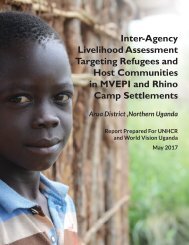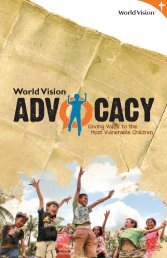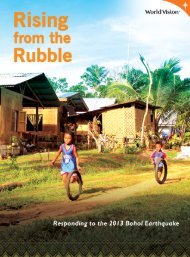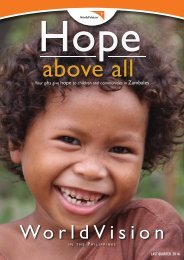SAENER18 Months On Report FINAL (NON-HiRES)
Create successful ePaper yourself
Turn your PDF publications into a flip-book with our unique Google optimized e-Paper software.
Farmer Rufino Hungulo is among the 33,000 beneficiaries of a subsistence farming project known as ‘Securing<br />
Angola’s Future’. The project aims to help farmers meet the food needs of rural households.<br />
Disaster Risk Reduction and Climate Change Adaptation<br />
World Vision defines resilience as the capacity of a system, community or society<br />
potentially exposed to hazards to adapt, by changing or resisting in order to reach<br />
and maintain acceptable levels of functioning and structure. SAENER’s Disaster Risk<br />
Reduction efforts strengthened community resilience by reducing their vulnerabilities<br />
and by developing capacities of individuals and communities to reduce risk and build up<br />
resilience. In Livelihood and Resilience projects, DRR was mainstreamed by ensuring that<br />
farmers receive subsidised drought tolerant crop seeds. Farmers were capacitated in fodder<br />
making, hence, reducing the impact of drought. Trainings on participatory scenario planning<br />
where beneficiaries were taught on risk reduction approaches such as identification of<br />
early warning systems, planting drought tolerant varieties, monitoring planting dates and<br />
other approaches that would help them to be more resilient were also conducted. Farmer<br />
Managed Natural Regeneration (FMNR) was also promoted for beneficiaries to understand<br />
concepts like catchment area conservation and specific vegetation that can be planted for<br />
conservation works. Provision of seeds to vulnerable households and conducting trainings<br />
on developing resilient cropping systems and improving agricultural practices, such as water<br />
harvesting, climate-safe agriculture, and conservation agriculture is contributing towards<br />
improvement of households’ food security in the long term. Climate Change and Adaptation<br />
interventions were implemented in the humanitarian response to ensure restoration of<br />
damaged resources/assets and environment respectively. Households were encouraged to<br />
establish an orchard and woodlot which will be used for fuel and poles for roofing houses as<br />
well as for selling to earn income. Awareness messages on environmental friendly farming<br />
technologies were done to all the beneficiaries and communities at large. Community assets<br />
were also created focusing on disaster risk reduction.<br />
24<br />
18 MONTHS ON REPORT Southern Africa El Niño Emergency Response (SAENER)










